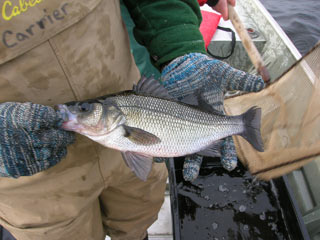White Perch
Morone americana
 Distribution: The white perch occurs in Atlantic slope drainages from the St.Lawrence River to South Carolina. Primarily a species of brackish water in nearshore habitats, the white perch has been introduced into a number of inland water bodies. White perch are relatively common in many lakes and ponds throughout New Hampshire.
Distribution: The white perch occurs in Atlantic slope drainages from the St.Lawrence River to South Carolina. Primarily a species of brackish water in nearshore habitats, the white perch has been introduced into a number of inland water bodies. White perch are relatively common in many lakes and ponds throughout New Hampshire.
Description: The white perch is related to the striped bass and the two species have similar fin structure, although the white perch is less streamlined and lacks the prominent lateral stripes of the striped bass. The white perch is silvery in color, with large scales, a dark lateral line, and two large spiny dorsal fins.
Species commonly confused with: Rock bass
Habitat: White perch are native to estuarine and coastal waters. They are often found over mud flats in tidal rivers. They have been introduced into a number of lakes and ponds, where they may be found in abundance at a variety of water depths.
Life History: White perch spawn in fresh or brackish water in tidal rivers. In lakes and ponds, white perch spawn in shallow water along the shoreline or in in the larger tributaries of the water body. Spawning usually takes place over a two week period in May or June, when water temperatures reach about 60°F (15°C). Spawning fish congregate in large groups, releasing eggs and sperm over a variety of substrates. White perch are a prolific species and may become extremely abundant in larger water bodies. A female may release between 20,000 and 300,000 eggs in the spring spawning season.
White perch usually live between 5 and 7 years. Fish eggs make up a large proportion of their diet when available, but they also feed on zooplankton, small minnows, and fish larvae. Feeding takes place in shallow water at night followed by a retreat to deeper water during the day. White perch are tolerant of a variety of habitat conditions, but they tend to thrive in water bodies that reach temperatures over 75°F (24°C).
Origin: Native/Introduced
Conservation/Management: There are no specific conservation or management objectives for white perch. White perch are a popular and excellent tasting gamefish. There is a 25 fish daily bag limit on white perch and other panfish in New Hampshire. In some cases, white perch populations may become so abundant that food sources become depleted in the water body and their growth may be stunted.



